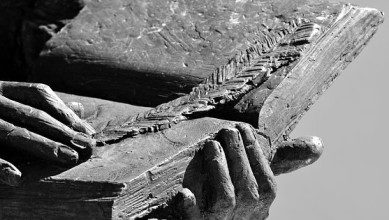
The Sound Machine is a short story written by Roald Dahl, published in 1949 as a part of his collection “The Complete Short Stories. The story narrates an episode in the life of Klausner, the protagonist, who is obsessed with sounds, so much so that others often find him to be out of his mind. Through his instability, the author highlights the theme of appearance vs. reality, making the reader wonder if there was indeed, like Klauser believed, an existence of a world beyond what we see or whether everything other than what can be seen is a mere illusion. Another prominent issue highlighted in the story is that of the ill-treatment of nature by the humans, especially the pains afflicted by us on the trees and plants without any care for their feelings. Though Kalusner’s concern for the trees and his efforts to relieve and protect them from further suffering at the hands of humans might appear to be absurd, the underlying spirit of a peaceful co-existence amongst all creations of God is quite sincere, and as a matter of fact, the need of the hour.
As the story begins, we are introduced to the central character, Klausner who harbours a deep interest in sounds that exist around, almost to the point of being labelled as a fanatic. He has developed a make-shift laboratory in a shed in his garden wherein he works upon his invention– a sound machine, which appears like a small coffin filled with numerous interconnected wires and tubes. He devotes extensive time to this project, fiddling with the wires and drawing diagrams, almost like a scientist, and displays unwavering concentration as he works and tests the device he has created. He keenly studies the mechanism occurring inside the box as he twiddles the dials of his radio-like sound box and it seems, from his state of nervous excitement, that he is nearing a breakthrough, which meant that his sound machine was finally ready to be put to use.
So engrossed is he in his work, that the arrival of his friend and doctor, Scott, startles him. The doctor tells him that he was passing by the house and so thought of checking on his throat, which was earlier giving him some trouble. Upon inquiry by the doctor regarding the complicated looking box, Klausner reveals that the device is related to his love for sounds and talks about its purpose and working. According to Klausner, there exist numerous sounds around us which, due to their high-pitch, are inaudible to the human ear. Now, this is technically correct, as humans can only hear sounds that range from 20 Hertz to 20 Kilo Hertz. Bats can hear within a range 9 kHz to to 200 kHz while dolphins can hear upto 160kHz! Heck, even your dog can hear much higher frequencies than you, at 45 kHz. And if you’re a cat person, your feline furball beats the doggos at 65kHz. So, what Klausner is talking about is technically correct and he’s not talking bollocks at his point at least.
The machine, which he has spent many hours developing, aims to record these vibrations and to then convert them into a scale that can be heard by humans. Cool! After having made some final changes in his device, Klausner believes that it is ready to be put to use and is very excited to test it. So, after the doctor leaves, he takes the box outside into his garden, plugs in his earphones (its definitely isn’t an airpod though), turns the dial meant for tuning the apparatus to the desired frequency ranging between 15000 to 1000000 vibrations, and waits to hear some new sound. The anticipation makes him both anxious and exhilarated, all at once and he listens, with utmost attention, for any sound other than the low humming of the machine itself. Suddenly, he hears a shrill scream, like that of a woman shrieking in agony, piercing through the otherwise still air. Looking around to identify the source of the sound, he sees no one except his neighbour, Mrs. Saunders, who is cutting flowers in the garden. Seeing her bend down to snip a rose stem he is convinced that she was not the one he heard, when all of a sudden, he hears the same screaming sound again at the exact moment when the stem is cut. Seeing this, an idea strikes him and eager to test his theory, he asks Mrs. Saunders to cut another stem.
Apprehensive of her peculiar neighbour, Mrs. Saunders thought it better to comply with his request. As soon as she cuts another stem, Klausner heard the same shrill scream again. Now fully convinced that it’s really the flowers that had screamed out in pain as the sharp scissors cut through them, he runs to Mrs. Saunders and tells her about his discovery, beseeches her to not harm the flowers any further.
He further tests his theory on daisies and when that also yields the same results, he is certain that the sounds he’s heard are coming from the plants who, when hurt, let out a scream. However, he realises that the scream, which he had earlier imagined to be a cry of pain, was in fact devoid of any expression or emotion known to humans. This, he assumed, is something of which we hadn’t the slightest idea, something known only to the trees and plants.
Early next morning, Klaunser tries his sound machine on a tree at his neighbourhood park. So, he switches on the machine, plugs in his earphones to an axe (it’s not a Samsung Earbud either), and strikes the tree at its base. As soon as the blade cuts the tree, he hears a new sound, unlike the one that came from the flowers. The cry is harsh and low-pitched, and fills Klausner with a sense of horror at the pain he felt he had inflicted on the tree.
Extremely regretful about his action, he apologizes to the tree and then, as if struck by a sudden thought, runs off to call Dr. Scott, asking him to come urgently to the garden. Upon his arrival, Klausner demonstrates the working of the sound machine to him, asking him to listen to the sound coming from the earphones plugged into the machine as he struck the tree. He implores the doctor to do as asked and assures him that the sound that he had heard is truly coming from the tree and not something he had imagined.
Though hesitant at first, the doctor complies with his wishes as he sees the thought driving Klausner crazy. However, just as the blade of the axe strikes the tree, a branch breaks off and falls, nearly crushing both the doctor and Klausner. Thankfully, both of them manage to save themselves, especially Klausner who is saved just in the nick of time. However, the sound machine is destroyed beyond repair.
Frightened and alarmed on having just escaped a serious accident, the doctor tries to leave the place but is opposed by Klausner who keeps insisting him to make certain that he had heard the tree scream. To his dismay, the doctor tells him that he was hardly able to make out any sound in the commotion caused by the branch falling upon them. Now Klausner is completely distraught and is filled with empathy for the extreme pain he believes to be felt by the trees and plants as humans thoughtlessly cut them. Thus, devastated by the utter insensitivity of mankind, Klausner is filled with remorse, and is beside himself with the guilt of this realisation. In such a state of frenzy, he asks the doctor to heal the tree’s wounds and apply iodine on it, maybe as a means to absolve himself from some guilt and to undo some of the wrong, albeit very little, that he had caused the tree.
Thus satisfied with helping the tree, Klausner is somewhat relieved and the story ends with him asking the doctor to keep a check on the tree’s recovery. Overall, the story very powerfully conveys the message of being mindful of our exploitation of nature. While the actions of Klausner may seem absurd to others, it is definitely based on the idea of empathy which many individuals lack in relation to the environment. The sound machine therefore is both a work of science fiction as well as environmental ethics. Thinkers like Peter Singer have focussed on the idea of suffering as a basis for ethical treatment of animals. The Sound Machines extends this line of thought to include plants as well. One may read this story as one that emphasizes on the ethical treatment of plants and seeks to inspire people to curb the mindless destruction of trees and plants.
The story also delves around the idea of Identity and what it means to be a Self that is largely misunderstood by others. Not only does this apply to the trees and plants whose suffering cannot be understood by humans, it also applies to the character of Klausner, who despite being viewed as an odd fellow is deeply empathetic about his surroundings and fellow creatures. It is a matter of irony that the branch of the tree destroys the very machine with which it had been possible to know about its suffering. However, one may also view it as a commentary on the limits of which it may be possible and the inevitable opposition between the natural world and humanity’s artificial inventions and technology, which all said and done have done more harm than good to the natural order of things.



